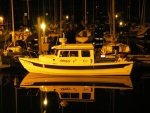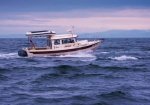colbysmith
Active member
- Joined
- Oct 2, 2011
- Messages
- 5,036
- Reaction score
- 14
- C Dory Year
- 2009
- C Dory Model
- 25 Cruiser
- Hull Identification Number
- UWH25301J809
- Vessel Name
- C-Traveler
Ok James and Bob, my younger brother got his laugh of the night I'm sure.... He is quite the Electronics guru, so even though he is my younger brother, I think he is one smart cookie when it comes to anything electrical, so I defer to him. FWIW, I'll just copy and paste his reply (without the laughter that I'm sure was going on as he typed....)
It sounds like your trying to make electricity out of thin air. Let me re confirm your question. You want to be driving down the road with your 12 volt inverter plugged into you boat 12 volt accessory outlet, to power your battery charger, to charge the boat battery's that's currently powering the inverter. This will absolutely not work. First off, there are power losses. Your inverter will use more juice than the battery charger will replace. Second, there would possibly be a ground loop type issue that could damage either the battery charger or inverter. You have to use a separate power source for your inverter. If you plug your inverter into your car accessory outlet, run the battery charger on that to charge your boat battery, that will work as long as you do not have your boat batteries tied/connected in any way to your car/towing electrical system, and the current rating of your accessory outlet is high enough to run your inverter, and the battery charger power requirement does not exceed the output of the inverter.
Example: If your accessory outlet has a 10 amp fuse, it will deliver up to 120 watts of power. If your inverter is 100 watt inverter, the accessory outlet will handle that ok. But, your battery charger will need to require no more than 100 watts of AC power, or the inverter won't be able to handle it.
So, lets look at an example. I have a Sears 12 volt 2 amp battery charger. It's input requires 120 vac at 0.79 amps. That equates to 120 volts X 0.79 amps = 94.8 watts of power (ohms law). Your 100 watt inverter will power my 2 amp battery charger. You have to run it on your car battery. Remember, your drawing just under 10 amps of current off your car battery to produce a measly 2 amps of charge on your boat battery, but that will work. You want to be driving the vehicle though to keep from running the car battery down, as your drawing about 8.3 amps in the above example.
To be clear. You can not run a power inverter on a battery, power a battery charger with that inverter, and then use that battery charger to charge the same battery your running the inverter on. If that was possible, we'd all have free power and no one would need an electric company/utility.
You could also install a battery isolator or simply a disconnect between your tow vehicle's electrical system (battery) and the boat electrical system (battery) that would allow the boat batteries to charge along with the car battery while your driving. Only problem, you'd have to use large gauge wire, because the current flow through the wire would be high if the boat battery is low. Current flow would gradually go down as the battery charged and became matched in charge to the auto battery.
If you had a current limiting device that simply limited the current to say 5 amps, you could use small wire or plug into your accessory outlet. The time required to charge the batteries would be longer.
In your case. Plug the inverter into your car accessory outlet and use a small battery charger on the boat battery. Probably have to run a small extension cord from car inverter to the boat charger. My guess is that your shore powered battery charger is going to put out about 10 amps of current or more, and will require more input power than your inverter can provide. Give me the info on your shore power battery charger and I'll let you know, but I'm guessing you inverter won't power it.
I do have a 1500 watt inverter I use to power my house on batteries when I don't want to run my generator, but it draws about 130 amps of current. I use 3 big ass deep cycle batteries wired in parallel. I'm sure it will run your shore power battery charger. lol
It sounds like your trying to make electricity out of thin air. Let me re confirm your question. You want to be driving down the road with your 12 volt inverter plugged into you boat 12 volt accessory outlet, to power your battery charger, to charge the boat battery's that's currently powering the inverter. This will absolutely not work. First off, there are power losses. Your inverter will use more juice than the battery charger will replace. Second, there would possibly be a ground loop type issue that could damage either the battery charger or inverter. You have to use a separate power source for your inverter. If you plug your inverter into your car accessory outlet, run the battery charger on that to charge your boat battery, that will work as long as you do not have your boat batteries tied/connected in any way to your car/towing electrical system, and the current rating of your accessory outlet is high enough to run your inverter, and the battery charger power requirement does not exceed the output of the inverter.
Example: If your accessory outlet has a 10 amp fuse, it will deliver up to 120 watts of power. If your inverter is 100 watt inverter, the accessory outlet will handle that ok. But, your battery charger will need to require no more than 100 watts of AC power, or the inverter won't be able to handle it.
So, lets look at an example. I have a Sears 12 volt 2 amp battery charger. It's input requires 120 vac at 0.79 amps. That equates to 120 volts X 0.79 amps = 94.8 watts of power (ohms law). Your 100 watt inverter will power my 2 amp battery charger. You have to run it on your car battery. Remember, your drawing just under 10 amps of current off your car battery to produce a measly 2 amps of charge on your boat battery, but that will work. You want to be driving the vehicle though to keep from running the car battery down, as your drawing about 8.3 amps in the above example.
To be clear. You can not run a power inverter on a battery, power a battery charger with that inverter, and then use that battery charger to charge the same battery your running the inverter on. If that was possible, we'd all have free power and no one would need an electric company/utility.
You could also install a battery isolator or simply a disconnect between your tow vehicle's electrical system (battery) and the boat electrical system (battery) that would allow the boat batteries to charge along with the car battery while your driving. Only problem, you'd have to use large gauge wire, because the current flow through the wire would be high if the boat battery is low. Current flow would gradually go down as the battery charged and became matched in charge to the auto battery.
If you had a current limiting device that simply limited the current to say 5 amps, you could use small wire or plug into your accessory outlet. The time required to charge the batteries would be longer.
In your case. Plug the inverter into your car accessory outlet and use a small battery charger on the boat battery. Probably have to run a small extension cord from car inverter to the boat charger. My guess is that your shore powered battery charger is going to put out about 10 amps of current or more, and will require more input power than your inverter can provide. Give me the info on your shore power battery charger and I'll let you know, but I'm guessing you inverter won't power it.
I do have a 1500 watt inverter I use to power my house on batteries when I don't want to run my generator, but it draws about 130 amps of current. I use 3 big ass deep cycle batteries wired in parallel. I'm sure it will run your shore power battery charger. lol



